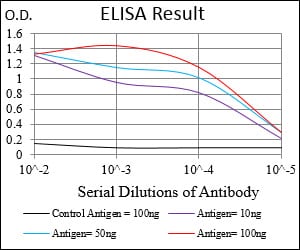
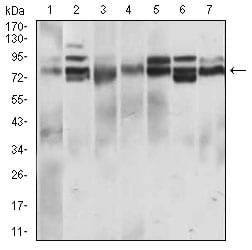
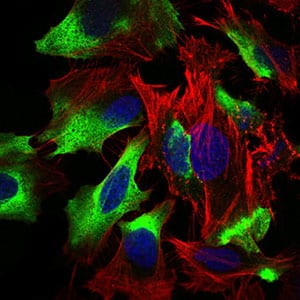
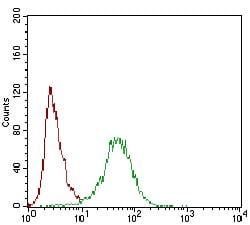
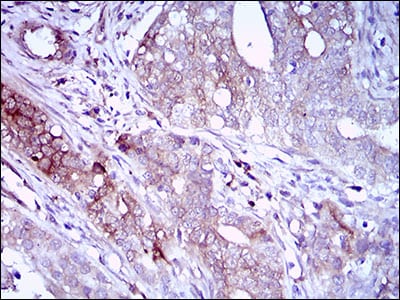
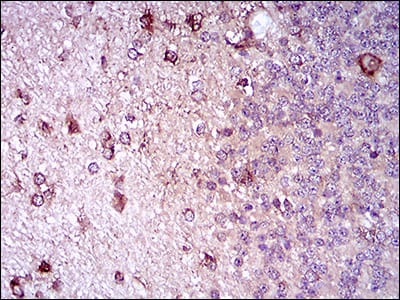
| WB | 1/500 - 1/2000 | Human,Mouse,Rat |
| IF | 咨询技术 | Human,Mouse,Rat |
| IHC | 1/200 - 1/1000 | Human,Mouse,Rat |
| ICC | 1/50 - 1/200 | Human,Mouse,Rat |
| FCM | 1/200 - 1/400 | Human,Mouse,Rat |
| Elisa | 1/10000 | Human,Mouse,Rat |
| Aliases | SIGLEC2; SIGLEC-2 |
| Entrez GeneID | 933 |
| clone | 2H1C4 |
| WB Predicted band size | 95.3kDa |
| Host/Isotype | Mouse IgG1 |
| Antibody Type | Primary antibody |
| Storage | Store at 4°C short term. Aliquot and store at -20°C long term. Avoid freeze/thaw cycles. |
| Species Reactivity | Human |
| Immunogen | Purified recombinant fragment of human CD22 (AA: 621-725) expressed in E. Coli. |
| Formulation | Purified antibody in PBS with 0.05% sodium azide |
+ +
以下是关于CD22抗体的3篇代表性文献及其摘要:
1. **文献名称**:*Inotuzumab Ozogamicin versus Standard Therapy for Acute Lymphoblastic Leukemia*
**作者**:Kantarjian H. et al.
**摘要**:该III期临床试验证实,靶向CD22的抗体药物偶联物Inotuzumab Ozogamicin在复发/难治性急性淋巴细胞白血病患者中疗效优于传统化疗,显著提高完全缓解率并延长无进展生存期。
2. **文献名称**:*CD22-CAR T Cells Induce Remissions in CD19-CAR Naïve and Resistant B-ALL*
**作者**:Fry T.J. et al.
**摘要**:研究报道了一种新型CD22靶向的CAR-T细胞疗法,可有效治疗CD19 CAR-T治疗失败或复发的B细胞急性白血病,证明CD22作为替代靶点的临床潜力。
3. **文献名称**:*Structural Basis of CD22 Phospho-Ligand Recognition by Human Siglecs*
**作者**:Wilson B.S. et al.
**摘要**:通过X射线晶体学解析CD22分子胞外域结构,揭示其与唾液酸糖基化配体的结合机制,为设计靶向CD22的抗体或小分子药物提供结构基础。
4. **文献名称**:*Bispecific Anti-CD19/CD22 CAR-T Cells for Relapsed B-Cell Malignancies*
**作者**:Goede V. et al.
**摘要**:探索双靶向CD19和CD22的CAR-T细胞疗法在B细胞淋巴瘤中的疗效,结果显示双靶向策略可降低抗原逃逸导致的复发风险,提升治疗持久性。
这些研究涵盖了CD22靶向治疗的抗体药物开发、结构机制解析及联合靶向策略等关键方向。
CD22. a 135-140 kDa transmembrane glycoprotein, belongs to the sialic acid-binding immunoglobulin-like lectin (Siglec) family. Primarily expressed on mature B cells, it functions as an inhibitory coreceptor that modulates B cell receptor (BCR) signaling to prevent excessive activation. Its extracellular domain mediates cell-cell interactions by binding α2.6-linked sialic acid ligands, while the intracellular domain contains immunoreceptor tyrosine-based inhibitory motifs (ITIMs) that recruit phosphatases to dampen BCR signals.
In B cell malignancies like non-Hodgkin's lymphoma and acute lymphoblastic leukemia (ALL), CD22 is overexpressed, making it a therapeutic target. CD22-directed monoclonal antibodies (mAbs) exploit this expression for precision targeting. Examples include epratuzumab (naked antibody) and inotuzumab ozogamicin (antibody-drug conjugate, ADC), the latter delivering cytotoxic payloads directly to CD22+ cells. These therapies show efficacy in relapsed/refractory cases, though antigen internalization and variable expression may limit responses.
Emerging approaches combine CD22 targeting with CAR-T cells or bispecific antibodies to enhance tumor killing. Beyond oncology, CD22 modulation is being explored in autoimmune disorders like lupus, where aberrant B cell activity drives pathology. However, challenges persist in overcoming CD22's rapid internalization and optimizing target-binding avidity. Ongoing research focuses on improving antibody engineering and combination strategies to maximize therapeutic potential while minimizing off-target effects.
×